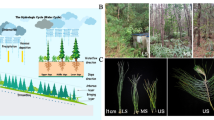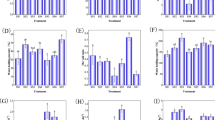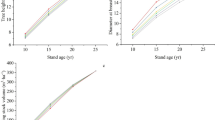Abstract
Calorific values of plants are important indices for evaluating and reflecting material cycle and energy conversion in forest ecosystems. Based on the data of Masson Pine (Pinus massoniana) in southern China, the calorific values (CVs) and ash contents (ACs) of different plant organs were analyzed systematically using hypothesis test and regression analysis in this paper. The results show: (i) the CVs and ACs of different plant organs are almost significantly different, and the order by AFCV (ash-free calorific value) from the largest to the smallest is foliage (23.55 kJ/g), branches (22.25 kJ/g), stem bark (21.71 kJ/g), root (21.52 kJ/g) and stem wood (21.35 kJ/g); and the order by AC is foliage (2.35%), stem bark (1.44%), root (1.42%), branches (1.08%) and stem wood (0.33%); (ii) the CVs and ACs of stem woods on top, middle and lower sections are significantly different, and the CVs are increasing from top to lower sections of trunk while the ACs are decreasing; (iii) the mean GCV (gross calorific value) and AFCV of aboveground part are larger than those of belowground part (roots), and the differences are also statistically significant; (iv) the CVs and ACs of different organs are related, to some extent, to diameter, height and origin of the tree, but the influence degrees of the factors on CVs and ACs are not the same.
Similar content being viewed by others
Article PDF
Author information
Authors and Affiliations
Corresponding author
Rights and permissions
About this article
Cite this article
Zeng, W., Tang, S. & Xiao, Q. Calorific values and ash contents of different organs of Masson pine (Pinus massoniana) in southern China. Nat Prec (2012). https://doi.org/10.1038/npre.2012.6750.1
Received:
Accepted:
Published:
DOI: https://doi.org/10.1038/npre.2012.6750.1
Keywords
This article is cited by
-
Comparison of calorific values and ash content for different woody biomass components of six mangrove species of Bangladesh Sundarbans
Journal of the Indian Academy of Wood Science (2019)



